Hut to hut hiking is a type of multi-day hiking in which you overnight in mountain huts (Hütten) along the way. It’s a very popular way of hiking in the Austrian Alps, because wild camping is not permitted.
There are hundreds of hut to hut hiking routes across the Austrian Alps, ranging from easy to extremely strenuous.
Austria is one of the best destinations for hut-to-hut hiking trips, because of the hospitality, cuisine, and comfort of the mountain huts. Austrian huts not only accommodate overnight guests, but they also serve food and drinks.
While huts are definitely rustic accommodations, they’re generally warm and cozy and offer the perfect place to rest and rejuvenate at the end of a long-distance hiking stage.
In this guide, we’re going to share everything we’ve learned about hut-to-hut hiking in Austria.
You’ll find out how to book Austrian mountain huts, where and when to go hut-to-hut hiking, how to save money, what to bring, and so much more.
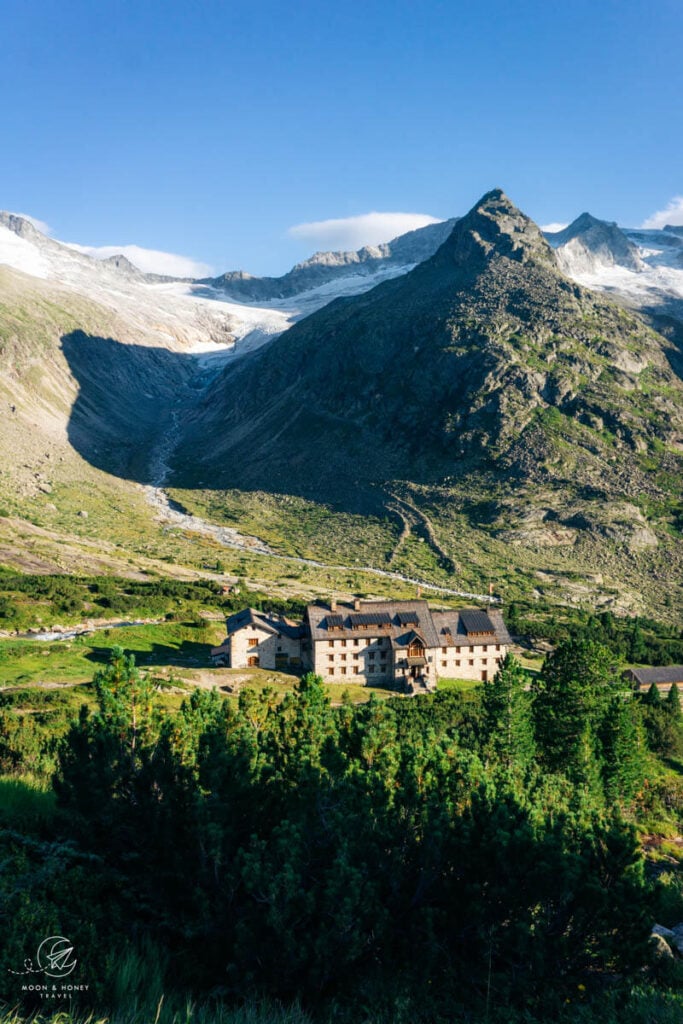
- The Austrian hut to hut hiking season starts in mid-late June and ends in mid-late September. Opening and closing times of huts vary depending on snow conditions.
- Choose an established hiking route for your hut-to-hut hiking itinerary.
- Mountain hut reservations are necessary. Depending on the hut, you can make reservations online, by email, or by phone.
- Make mountain hut reservations 2-5 months in advance. If your dates are flexible, you can book a few weeks in advance.
- You don’t need to speak German to hike in Austria, but you should be familiar with a few helpful German phrases and words.
- Join the Austrian Alpine Club to save money and get mountain rescue insurance.
- Learn about Austrian mountain hut etiquette.
- Bring cash and budget 60-80 EUR per day per person (minimum). In some huts, you can pay with a credit card, but those are few and far between. Always bring cash to be safe.
- Pack these essentials: Kindle, Hiking Poles, Reusable Water Bottles, 36-38 L Backpack like the women’s Osprey Kyte, or the men’s Osprey Kestrel.
- Memorize Emergency Numbers 140 and 112.
1. You Can Hike Hut-to-Hut in the Austrian Alps from Late June until Late September

The hut to hut hiking season commences in June. Mountain hut opening and closing times vary slightly each year, depending on snow conditions.
But, as a rule, most huts will open by mid-late June. And, most huts will close by the end of September. Though, some may stay open until early-mid October.
Some huts, situated at lower elevations, may open up as early as mid-May.
If you’re planning an international/overseas trip to the Austrian Alps, we recommend avoiding the very beginning and very end of the hiking season.
Come in July, August, or early September, to be on the safe side.
To find the exact opening and closing dates of a specific hut, just Google the name of the hut. Most (if not all) huts have their own websites.
2. Choose an Established Hiking Route for Your Hut-to-Hut Hiking Trip

Austria has hundreds of established hut-to-hut hiking routes. The good news is that you don’t have to create a hut-to-hut hiking itinerary from scratch.
Simply, follow one of the many established Höhenwege (High Trails) or Hüttenrunden (Hut Circuits).
The bad news is that there are too many options (well, that’s good too). Below, we’ve linked to our favorite hut to hut hiking trails in Austria.
If you want to read a brief summary of each trail, read: Trekking Austria.
After choosing an established route, you’ll know exactly which mountain huts to book. For example, in the Karwendel High Trail (East to West), the stages are as follows:
Stage 1 | Scharnitz – Hallerangerhaus
Stage 2 | Hallerangerhaus – Bettelwurfhütte
Stage 3 | Bettelwurfhütte – Pfeishütte
Stage 4 | Pfeishütte – Solsteinhaus
Stage 5 | Solsteinhaus – Nördlinger Hütte
Stage 6 | Nördlinger Hütte – Reith bei Seefeld
Hut to Hut Hiking Trails in the Austrian Alps
We’ve ordered these trails according to difficulty, easiest to most difficult.
Emperor’s Crown (Kaiserkrone) in Tyrol
Rätikon High Trail in Vorarlberg
Montafon Hüttenrunde in Vorarlberg
Karwendel High Trail in Tyrol
Schladminger Tauern High Trail in Styria
Venediger High Trail in East Tyrol
Berlin High Trail in Tyrol
Eagle Walk- Lechtal Alps Stages in Tyrol
2-Day Hut Hikes
Hochschwab Summit in Styria
Hesshütte in Gesäuse National Park in Styria
Self-Guided Hikes
If you need support booking huts, you can work with a self-guided hiking company like Alpenventures UNGUIDED.
These companies make reservations on your behalf and provide additional support so that your hiking trip is seamless.
6 Day Hut to Hut Light in the Austrian Alps – This hut-to-hut hiking route is appropriate for families with children who already regularly hike.
8 Day Culinary Delight Hut Hiking Tour
3 Day Culinary Delight Extended Weekend Hiking
Austria Hut to Hut Hiking Guidebooks
Trekking in the Zillertal Alps
Trekking in Austria’s Hohe Tauern
Modifying Multi-Day Hiking Trails
You can modify an official hiking route. For example, if the hiking trail you’re interested in is 8 days, but you only want to hike 4, you can.
Most huts have exit routes, so you can shorten, or strategically cut out parts of a multi-day hiking trail. We’ve shortened hikes, due to poor weather, budget reasons, or by recommendation.
However, I wouldn’t combine stages, unless you’re very familiar with the mountain range, or upon recommendation.
Stages along Höhenwege (High Trails) may seem very short compared to long-distance trails in other parts of the world.
These short stages can be very technically demanding and require much more time, concentration, and energy than you anticipate.
For example, Stage 21 of the Eagle Walk from Württemberger Haus to Memminger Hütte is 7 km, and Stage 22 of the Eagle Walk from Memminger Hütte to Ansbacher Hütte is 10 km. Thru-hikers might be tempted to combine these stages.
But, given the terrain, elevation gain/loss, and trail difficulty, it would be a mistake to combine these very challenging stages.
Trail Difficulty
Hiking trails in Austria are differentiated by color based on difficulty. In the mountains, you’ll usually encounter:
- Red Trails: Moderate, marked hiking trails
- Black Trails: Difficult, marked hiking trails
- Alpine Route Trails: Extremely challenging (and dangerous) hiking trails for expert hikers only. Standard hikes and high trails avoid these routes.
On Austrian trail maps, the technical difficulty is usually indicated by the type of line. A straight line is easy-moderate, a dashed line signifies moderately difficult, and a dotted line means very challenging.
Most Höhenwege (High Trails) are moderately difficult to extremely difficult. Kati and I gravitate to these trails because we like the challenge, the peace, and the scenic beauty that usually accompanies high mountain trails.
If you’re new to hiking in the Austrian Alps and are looking for something moderate, check out these hikes:
Emperor’s Crown in Wilder Kaiser in Tyrol
Lechquellenrunde (German) in the Lechquellen Mountains in Vorarlberg
Kat Walk in Kitzbühel Alps in Tyrol
Salzburger Almenweg in Salzburg
Waymarks

Hiking Trails in Austria are marked with red – white – red stripes, just like the Austrian flag. Sometimes the waymark is just a splash of red paint on a rock.
Hiking trails are very well maintained and signed in Austria. You’ll rarely encounter any issues with navigation given the prevalence of trail markers and signage.
However, early in the season, when snow is still present, high mountain trails may still be obscured and some signs may be bent/missing, due to winter storms.
Permits
You do not need to secure any permits before embarking on a hut to hut hiking trip in Austria.
3. Overnight Hut Reservations are Imperative

Once you decide which hiking trail you want to hike, create a list of the huts along the trail and begin making reservations.
In the past, hikers didn’t need to make reservations to stay in mountain huts in Austria. However, with the growing popularity of multi-day trekking in Austria, reservations are vital.
How to Make Reservations for Austrian Mountain Huts
There is no uniform system for booking mountain huts in Austria.
Online Reservations
Many huts in Austria, managed by the Austrian Alpine Club (ÖAV) and the German Alpine Club (DAV), can be reserved online using the Alpsonline.org platform.
To find out if a mountain hut is on Alpsonline, just google “Alpsonline” along with the name of the hut. Alternatively, you can usually navigate to the specific Alpsonline hut page from the website of a mountain hut.
Note: you don’t need to be a member of the Austrian Alpine Club to use Alpsonline. Anyone can use the platform.
Alpsonline Reservation Platform
We’ve outlined these steps with screenshots in How to Visit Austrian Mountain Huts.
When you navigate to the specific hut reservation page on Alpsonline.org (e.g. Pfeishütte), select your date of arrival. Here, you’ll see the exact availability for any given date. In the top right corner, you can change the language to French, Italian, or English.
Step 1 (Accommodation). After selecting the date, you’ll be directed to the reservation form, where you can fill out the number of nights (usually just one), number of beds, group name, etc…
Step 2 (Identification). Next, select Guest (no login) if you’ve never reserved a hut before on Alpsonline.
Step 3 (User Information). After filling out your personal data (name, address, phone number, email), make sure to select “Save my personal data for future reservations,” before continuing to the next step.
If you selected “Save my personal data for future reservations,” the next step will prompt you to create a username (your email) and password.
Now that you’re a user, you can make reservations for huts more efficiently. You won’t have to fill out your personal data each time you make a reservation.
Continue to Step 4 (Summary), where you can review your reservation once more, before making your reservation.
You’ll receive an email confirming your reservation. If you need to cancel your reservation, go to this email and click “diesen Link” in the sentence: “Falls Sie die Reservierung ändern oder stornieren möchten, benutzen Sie diesen Link oder loggen Sie sich im Hüttenreservierungssystem ein.”
Email / Phone Reservations
However, not all Austrian huts are on that platform. If you can’t reserve a hut online, you can either email, or call the hut directly.
When reaching out to a hut directly, make sure to inform them of the following:
Reservation Name
How many beds you want to reserve. You can usually choose between reserving places in the Matratzenlager (dormitory), Mehrbettzimmer (rooms with multiple beds), or Zweitbettzimmer (room with 2 beds).
Date of Arrival
Number of nights you wish to stay
Alpine Club Membership: Are you a member of an Alpine Club?
Half-Board or À la carte. When you make a reservation, the hut manager (or the online form) will ask you if you want Halbpension (half-board: breakfast and dinner). Depending on the hut, you may want to opt for half board, or you may want to order À la carte. Some huts only offer half-board.
Dietary Restrictions. When you make a reservation, it’s important to communicate any dietary restrictions you have. In Austrian huts, there will always be a vegetarian option. However, it’s rare to find vegan or gluten-free meals on a menu. In most cases, Austrian mountain huts will be able to accommodate you, with enough notice.
If you can’t make a reservation by email, you can call the hut directly. To make international calls, we recommend using Skype. You can purchase Skype credits and then make international calls until your credit runs out.
Cancelling Mountain Hut Reservations
If your hiking plans have changed, make sure to cancel your hut reservations.
If you don’t cancel your reservation in advance, huts reserve the right to charge you. When booking huts online (Alpsonline), the cancellation policy will be clearly stated.
Additional Info:
Some huts are dog-friendly, but not all. If you want to stay overnight in a hut with your dog, check the hut’s website, or contact them directly to see if dogs are allowed.
Some huts in popular regions require a deposit for reservations.
4. Make Reservations for Austrian Mountain Huts 2-5 Months in Advance
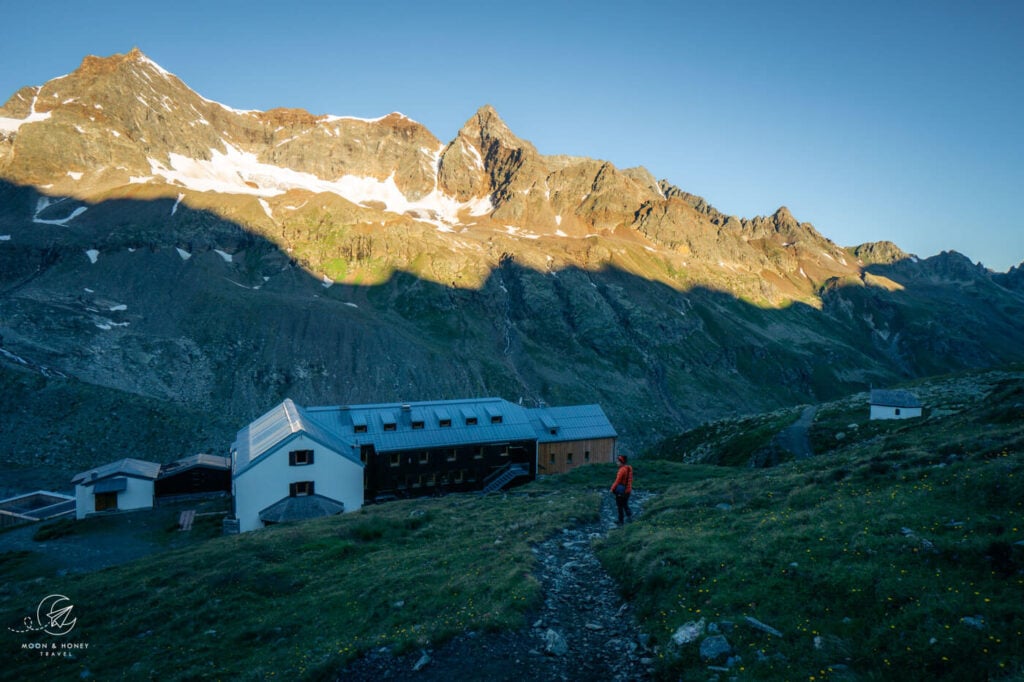
We recommend booking Austrian huts 2-5 months in advance, especially if your dates aren’t flexible and you want to sleep in a private room (Zweibettzimmer: room with 2 beds).
If you’re flexible about where you sleep and don’t mind sharing a room with other people – either in a Mehrbettzimmer (room with multiple beds) or in a Lager (dormitory) – then you don’t need to book so far in advance.
Note: not all huts offer private rooms.
We’ve successfully booked treks in Austria 5-months in advance as well as 2-weeks in advance.
5. Learn these German Phrases for Hiking in Austria
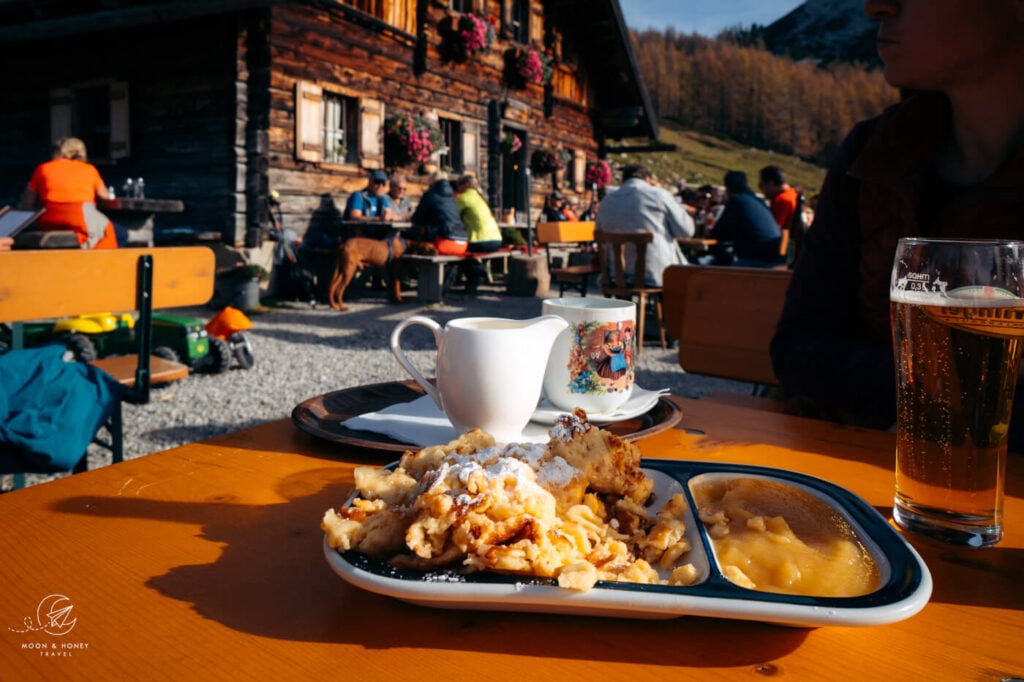
Austria relies heavily on German, Swiss, and Dutch tourism. So, there hasn’t been a pressing need to translate instructions, menus, and signs into English.
While you don’t need to speak German to hike hut-to-hut in Austria, it’s really helpful to know a few words and phrases, so you can better navigate trails, menus, and mountain huts.
Greetings
Hallo: Hi!
Servus: Hi / Bye!
Servas: Hi / Bye!
Griaß di: Howdy (to one person)!
Griaß eich: Howdy (to two or more people)!
Griaß enk: Howdy (to two or more people)!
Grüß Gott: Hello! It originally comes from the phrase “May God Bless You.”
Farewell Salutations
Pfiat di: Bye to one person!
Pfiat eich: Farewell to two or more people
Pfiat enk: Farewell to two or more people
Auf Wiedersehen: Goodbye
Tschüss: Bye
Servus: Hi / Bye!
Servas: Hi / Bye!
Geography
Berg: mountain
Joch: notch, or saddle
Scharte: wind gap, or notch
Bergsattel: mountain saddle
Spitze: peak
Gipfel: peak
Kamm: ridge
Grat: ridge
Bach: stream
Tal: valley
Alm, or Alpe: alpine pasture
Wald: forest
See: lake
Fluss: river
Mountain Hut
Hütte: mountain hut
Öffnungszeiten: opening times
Lage: location
Zustieg: approach
Hüttenpächter/Hüttenpächterin: Hut manager
Wirt: host, innkeeper
Preise: price
Kosten: costs
Barzahlung: cash payment
Anzahlung: deposit
Zimmer: room
Matratzenlager: mattress dormitory
Mehrbettzimmer: rooms with multiple beds
Zweibettzimmer: rooms with 2 beds
Trockenraum: drying room
Hüttenschuhe / Hauschuhe: hut shoes like crocs
Dusche: shower
Münze: coin
Gaststube: parlour, lounge, restaurant
Speisesaal: dining room
Alpine Pastures
Alm: alpine pasture
Almhütte: alpine pasture hut
Nicht Bewirtschaftet: not managed. When an Alm is not managed, it means they don’t sell food and drinks.
Bewirtschaftet: managed. When an Alm is managed, they sell food and drinks during the day.
Ruhetag: rest day. Many alpine pasture huts have rest days (e.g. closed Tuesdays). Some Almhütten are only open when the weather is good.
Achtung Weidevieh: Attention grazing cattle/animals
Hiking
Wanderung: a hike
Bergwanderung: a mountain hike
Weitwanderweg: long distance trail
Etappe: stage
Nur für Geübte: only for experienced (hikers)
Ungesicherter Steig: unprotected route.
Klettersteig: via ferrata route
Steil: steep
Ausgesetzt: exposed
Anspruchsvoll: Challenging
Einfach: easy
Vorsicht: attention
Steinschlag: rockfall
Lawinengefahr: danger of avalanches
Mure: landslide / mudflow
Rutschgefahr: slip hazard
Wegsperre: blocked path
Verletzung: injury
Hilfe: help
Wettervorhersage: weather forecast
Cableways
Seilbahn: Gondola
Sessellift: Chairlift
Bergstation: mountain station
Talstation: valley station
Food
Speisekarte: menu
Selbstbedienung: self-service, where you order and pick up your food at the counter.
Halbpension: half board (breakfast and dinner)
Frühstück: breakfast
Abendessen: dinner
For specific food dishes (soups, main dishes, vegetarian dishes, desserts) and drinks, read our guide to visiting Austrian Mountain Huts.
6. Join the Austrian Alpine Club
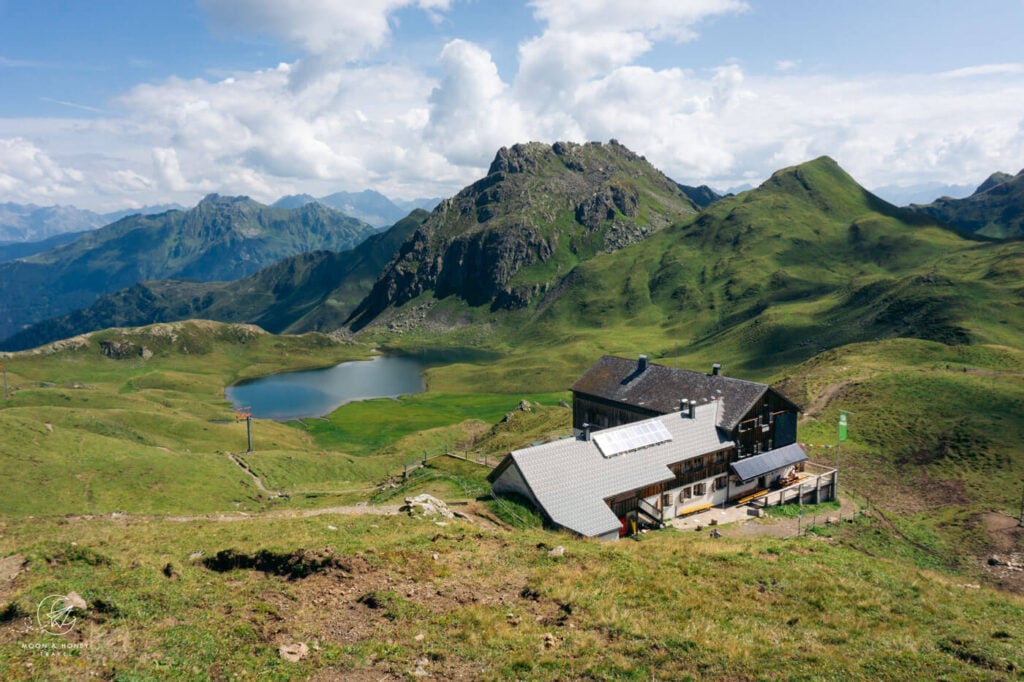
By joining the Austrian Alpine Club (ÖAV), you get a significant discount on overnight stays in mountain huts, which have contracts with the Austrian Alpine Club. You must present your alpine club membership card to receive the discount.
There are tons of alpine clubs throughout Europe, so just check the Mutual Rights Agreement to see whether your alpine club grants you the same privileges in Austria.
If you belong to any of the following alpine clubs (members of UIAA, which participate in the International Reciprocal Agreement on Mountain Huts), you are entitled to the same benefits as Austrian Alpine Club members.
- German Alpine Club (DAV)
- Austrian Alpine Club (ÖAV)
- South Tyrol Alpine Club (AVS)
- Swiss Alpine Club (SAC)
- Club Alpino Italiano (CAI)
- Club Alpin Français (CAF)
- Federación Española de Deportes de Montaña y Escalada (FEDME)
- Liechtenstein Alpine Club (LAV)
- Slovenian Mountaineering Association (PZS)
- Club Alpin Belge (CAB)
- Groupe Alpin Luxembourgeois (GAL)
- Dansk Bjergklub
- Federazione Alpinistica Ticinese Switzerland (FAT)
- the Nederlandse Klim- en Bergsportvereniging (NKBV)
Similarly, when we hike in Slovenia, we can present our ÖAV cards and receive alpine club discounts in Slovenian mountain huts.
Note: To be an ongoing member, you have to pay an annual fee.
Another reason for joining an Alpine Club is for mountain rescue and repatriation insurance.
7. Learn about Austrian Mountain Hut Etiquette
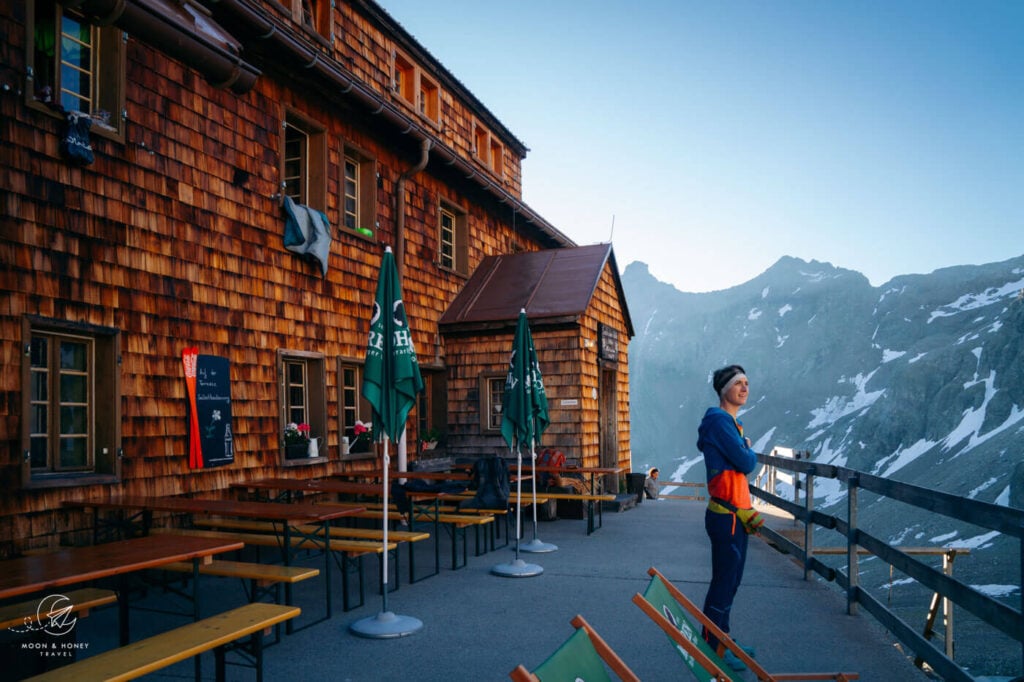
Most Austrian mountain huts are either owned by the Austrian Alpine Club or the German Alpine Club.
Huts are managed by individuals who have been vetted for the role. The life of a mountain hut manager is demanding. They spend months running remote huts with very little time off.
So, when you visit a mountain hut, it’s kind of like visiting someone’s home. You want to be courteous, respectful, and follow the rules.
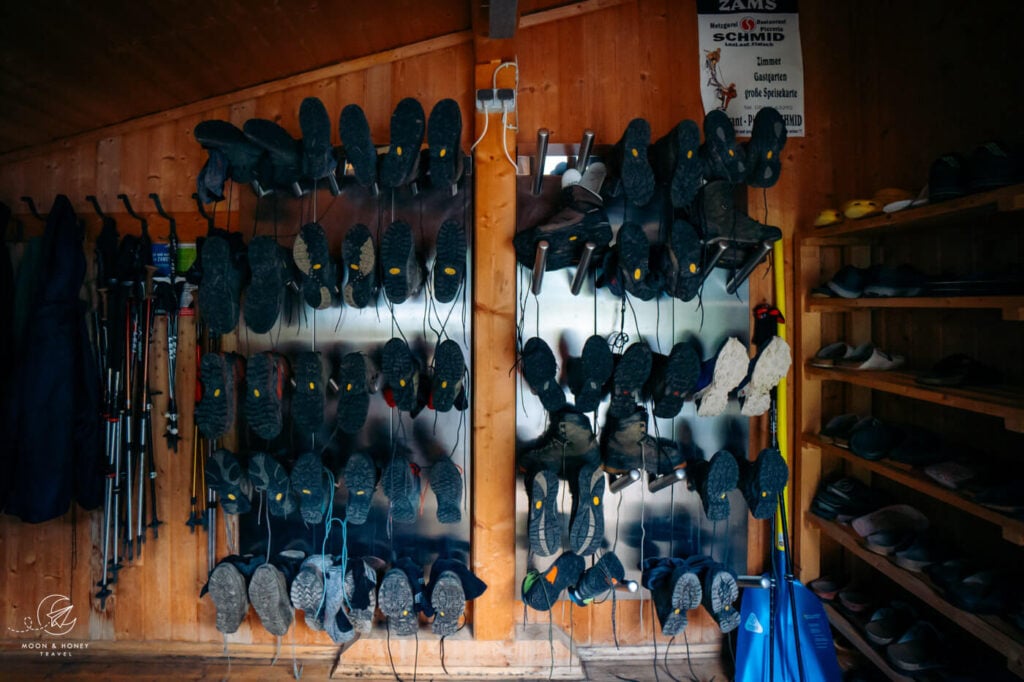
Here are few guidelines to follow:
1. Before entering the sleeping quarters (dormitories/bedrooms), take off your hiking shoes. There will always be a designated space to place your boots – either in the entryway or in a dry room (Trockenraum). Do not bring your shoes into the bedrooms. Many huts also provide Hüttenschuhe (hut shoes/slippers), but we always bring crocs to wear in the huts.
2. Dry wet clothing outside (on clothing lines) or in dry rooms.
3. Upon arrival, check-in. Checking in usually involves stating your name, showing your Alpine Club Membership Card, buying shower tokens, and sometimes ordering your dinner. After checking in, you’ll be directed to your room, after taking off your shoes. The staff will also inform you about what time dinner and breakfast are served. Often, they’ll show you where you’re supposed to sit for dinner.
4. Come to dinner on time and sit in your assigned spot. In most Austrian huts, seating is arranged by the staff. You’ll usually share a table with other hikers. This ensures that no one eats alone. Never ask to be seated alone.
5. Come to breakfast on time. Breakfast is usually laid out as a buffet. Breakfast is usually available for 1 hour or 90 minutes.
6. Austrian huts are often lively places, fostering an atmosphere of celebration and conviviality (especially when Schnaps are readily available). Enjoy yourself, but don’t overdo it – you don’t want to be hungover during your hut-to-hut hike.
In Austrian culture, it’s really important to make purposeful eye contact when you toast. Say Prost or Zum Wohl. You should tap glasses with everyone within reach.
Say Mahlzeit right before anyone at your table begins to eat. It means “enjoy your meal.”
7. Hüttenruhe (Hut Quiet Time) begins at 10 pm.
8. Pay at night, before you go to bed.
9. Bring a sleeping bag liner. We recommend this Sea to Summit Silk-Cotton Blend liner. Blankets and pillows are always provided.
10. Do not eat in bedrooms.
11. Do not eat your own food in mountain huts. It’s considered rude. Hut managers and staff make their living by selling food in the huts. Overnight fees go directly to the Alpine Club.
12. Do not leave your trash in the huts. Pack out your trash and dispose of it responsibly in the valleys.
8. Bring Enough Cash and Budget for at Least 60-80 EUR per Person per Day
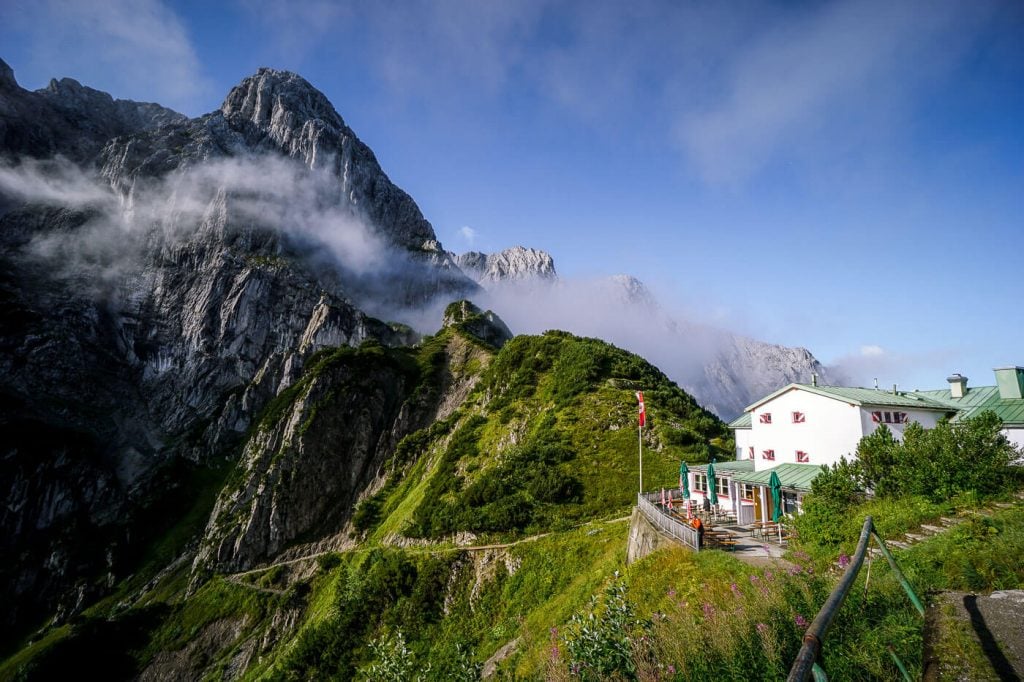
How Much Does it Cost to Spend the Night in an Austrian Mountain Hut?
Overnight costs in Austrian Hütten will vary depending on:
Type of mountain hut. There are three categories of mountain huts in Austria. Huts that are more remote and serviced only by helicopters are slightly more expensive than huts that can be provisioned by road.
Alpine Club membership. If you have an alpine club membership, you’ll get a discount on your overnight stay in Austrian mountain huts.
Type of room. Huts generally have different types of rooms. If you stay in a Zweibettsimmer (room with 2 beds), you’ll pay a lot more than in a Matratzenlager (mattress dormitory), or Mehrbettzimmer (large room with beds).
Your age. Depending on the hut, prices may vary by age: adult (18+ years old), youth (7-18 years old), and children (0-6 years old). Sometimes, there’s an additional Junior category for persons aged 19-25.
Adult prices for staying in Austrian mountain huts without Alpine Club Membership (Nicht-Mitglieder):
- Matratzenlager (mattress dormitory): 18 – 25 EUR
- Mehrbettzimmer (rooms with multiple beds): 22 – 35 EUR
- Zweibettzimmer (rooms with 2 beds): 35 – 40 EUR
Adult discounted prices for Alpine Club Members (Mitglieder):
- Matratzenlager (mattress dormitory): 9 – 13 EUR
- Mehrbettzimmer (rooms with multiple beds): 12 – 22 EUR
- Zweibettzimmer (rooms with 2 beds): 19 – 25 EUR
Food and Drink
Most huts offer a half board option, which includes breakfast and dinner. Some huts only have an à la carte dinner menu, while other huts offer both.
Half board (breakfast and dinner) usually costs around 30 EUR per person. Half board does not include beverages.
Depending on the hike, you may want to order a Lunchpaket (Packed Lunch).
We always order a Lunchpaket (in the evening), when we know that there are no mountain huts situated along the next day’s stage.
Showers
Some mountain huts have showers, which are usually token-operated. Tokens usually cost 3 – 4 EUR for a 3 – 4 minute shower.
One Night in an Austrian Mountain Hut
Overnight in Dormitory: 9 EUR – 25 EUR
Half Board: 30 EUR
3 Drinks: 15 EUR
At a minimum, it costs 54 -70 EUR to stay the night and eat breakfast and dinner in an Austrian hut.
9. Austrian Alps Hut-to-Hut Hiking Essentials
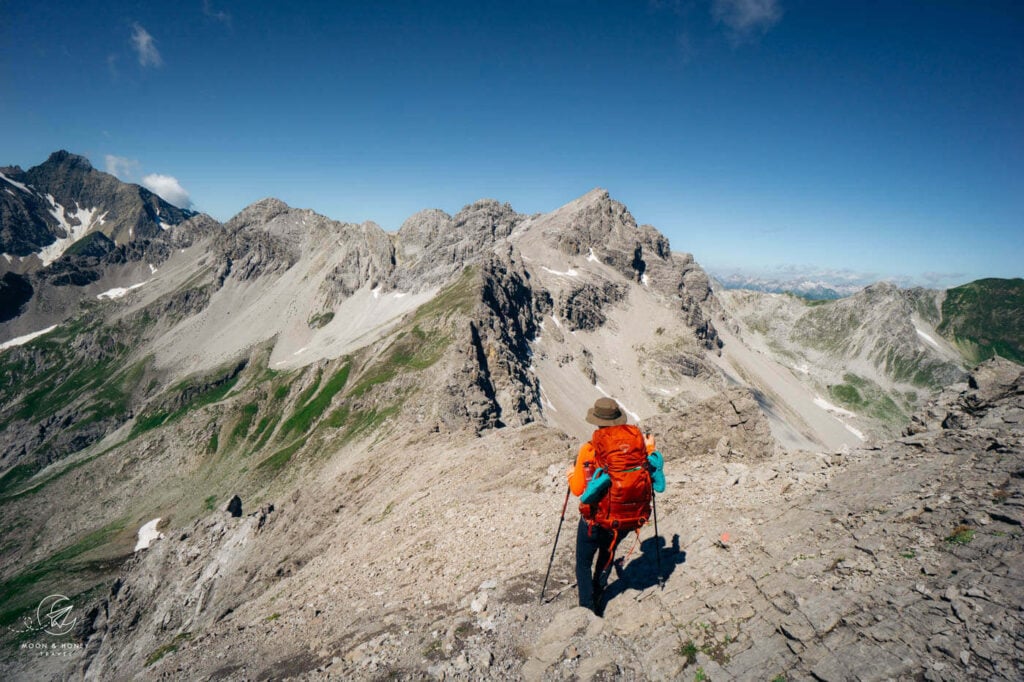
Read our Hut to Hut Hiking Packing List for a comprehensive list of things to pack for a hut-to-hut hiking trip in Austria.
Hiking Gear
Backpack | The Osprey Kyte 36 (for women) and the Osprey Kestrel 38 (for men).
Hiking Boots | Grade B/C, high-cut hiking boots like the women’s Hanwag Tatra II GTX / Meindl Schuhe Island Lady (what Kati and I wear) or the men’s Hanwag Tatra II GTX.
Sunglasses | Cat 4 Sunglasses like the Julbo Shield Mountain Sunglasses
Trail Poles | Unisex Black Diamond Hiking Poles
Hiking Gloves | Black Diamond Climbing Gloves. Though optional, gloves will help you safely and comfortably grip cables along high routes.
Reusable Water Bottles | You can fill up your water in most huts for free. If the tap water isn’t drinkable in the hut, there will be a sign. We both carry two 1-Liter water bottles each.
Mountain Hut Essentials
Sleeping Bag Liner | All you need for your overnight stay in a mountain hut is a lightweight (silk) sleeping bag liner. Blankets and pillows are provided in the huts. We recommend the Sea to Summit Silk-Cotton Blend liner. More options Cocoon Cotton TravelSheet and Sea to Summit Premium Silk Sleeping Bag Liner.
E-reader | There’s always ample time to read before dinner, or before bed. We always download a few books on our Kindle before a hut hiking trip.
Waterproof House Slippers | We always bring our Crocs to wear in the huts. Crocs are great because they’re waterproof (perfect for showering), lightweight, and suitable for sock-wearing (unlike flip flops). Note: many huts provide slippers. But, do you really want to wear communal slippers?
Photography Gear for Hut to Hut Hiking in Austria
Camera Body | Sony Alpha a6400
Mid-range Zoom Lens | Tamron 17-70mm 2.8 Di III-A VC RXD
Wide angle Zoom Lens | Sony – E 10-18mm F4 OSS Wide-angle Zoom Lens
Backpack Camera Clip | Peak Design Camera Clip
10. Memorize the Phone Numbers 140 and 112 in Case of an Emergency
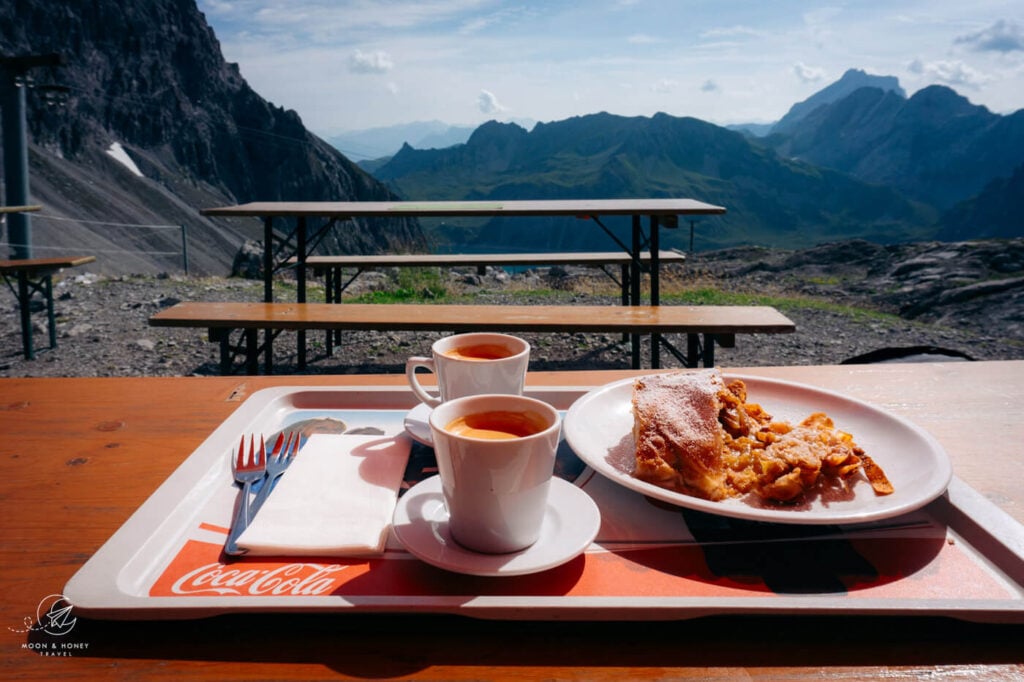
Austrian Alpine Emergency Number (Alpinnotruf): 140
European Emergency Number: 112
After making an emergency call:
Keep your mobile phone switched on.
Do not make any other calls.
Austria Trip Planning Essentials
Use our Austria Travel Guide and Austria blog archive to plan a unique and memorable trip to Austria.
When to Visit Austria
Summer and early Fall are our favorite seasons in Austria.
Getting around Austria
Austria has an excellent public transit system. We’ve used it extensively to travel throughout the country. We highly recommend using transit if you’re visiting cities (Vienna, Salzburg, Innsbruck, Graz, etc…), and/or doing hut-to-hut hikes.
Some areas like Mayrhofen, Schladming and Lech am Arlberg have wonderful seasonal transit systems in place (e.g. summer hiking buses). However, if you’re not visiting during the high season, bus frequencies are significantly reduced and it’s far easier to get around with your own vehicle.
If you’re planning on visiting multiple destinations across Austria, we recommend renting a car.
Use these road trip itineraries for trip planning inspiration:
- 2 Week Austria Road Trip – starting in Vienna
- 1 Week Austria Road Trip – starting in Salzburg or Munich
- 10-Day Bavarian Alps & Tyrolean Alps Road Trip – starting in Munich
Car Rental
We recommend using the Discovercars.com car rental reservation platform to search for and book car rentals. This easy-to-use booking platform compares car rental deals from 500+ trusted providers, so that you can choose the best option for your trip.
If you’re driving into Austria from a neighboring country, don’t forget to purchase a vignette at/near the border.
Hiking in Austria
Where to Hike in Austria
Read Austrian Alps Hiking Destinations for an overview of where to hike in Austria, with tips on specific trails and where to stay. Also check out Best Day Hikes in Austria and these region-specific hiking guides:
- Innsbruck Hiking Guide
- Salzburg Hiking Guide
- Filzmoos, Salzburg Hiking Guide
- Schladming, Styria Hiking Guide
- Lech am Arlberg, Vorarlberg Hiking Guide
- Vorarlberg Hiking Guide
- Vienna Mountains Hiking Guide
What to See & Do in Austria
- Visit a gorge like the Liechtenstein Gorge in Salzburg, or Wolfsklamm Gorge in Tirol.
- Bathe in the thermal pools of an Austrian Therme like Aqua Dome in Tirol.
- Stay in a thermal spa hotel like Rogner Bad Blumau in Styria, EurothermenResort Bad Ischl in Upper Austria, or the Aqua Dome Hotel in Tirol.
- Hike to a mountain lake like Lake Tappenkarsee in Salzburg or Lake Drachensee in Tirol.
- Go Wine Tasting in South Styria.
- Marvel at the culture, music, and architecture of Vienna.
- Eat heartwarming mountain food in an Almhütte at Grosser Ahornboden in Tirol or Ursprungalm in Styria.
- Drive the Grossglockner High Alpine Road in Hohe Tauern National Park.
- Visit the castles, monasteries, and wine taverns of the Wachau Valley, a UNESCO World Heritage Site.
Austrian Hotels
- Best Hotels in the Austrian Alps
- Best Hotels in Lech am Arlberg, Vorarlberg
- Wellness Hotel Theresa, Zillertal, Tirol
- Hotel Eder in Maria Alm, Salzburg



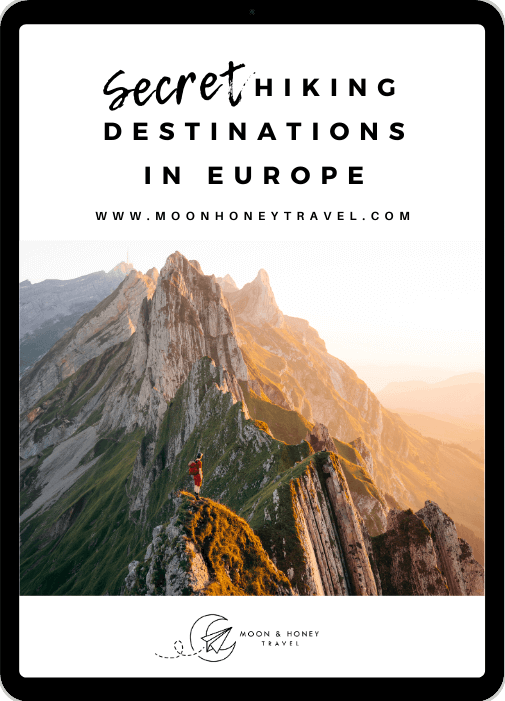
Very helpful! Do you know if you can rent sleeping bags in Austria from the alpine club? I have looked online but can’t find anything and we will be coming to Austria as part of a longer trip so won’t have space to bring our own bags
Hi Kristin,
Now that the pandemic is mostly over, the sleeping bag rule no longer applies. You only need a lightweight sleeping bag liner like this Sea to Summit Silk-Cotton Blend Travel liner.
-Sabrina
Hello!
Are there any hut hikes you recommend near Innsbruck?
Thanks!
Nik
Hi Nik,
Yes – check out the Karwendel High Trail.
-Sabrina
Hi,
Do you know of a travel agency that sends luggage between huts?
Hi Tal,
Luggage transfer will not be possible for most of the hikes we’ve written about. But, I would reach out to the local tourist office to find out if they have any solutions.
Kind regards,
Sabrina
Hi,
My hiking partner is vegan. How should we plan around this? I don’t want to be rude and bring our own food to the hut but I am assuming most of them do not have vegan options. Thanks!
Hi Max,
I would reach out to the huts you’re staying in and ask them if they can accommodate a (overnight) guest with a vegan diet (mention the date you’re coming, etc…). I think it’s usually possible, if they know in advance. And, if for some reason, they say they can’t, then bring your own food.
All the best,
Sabrina